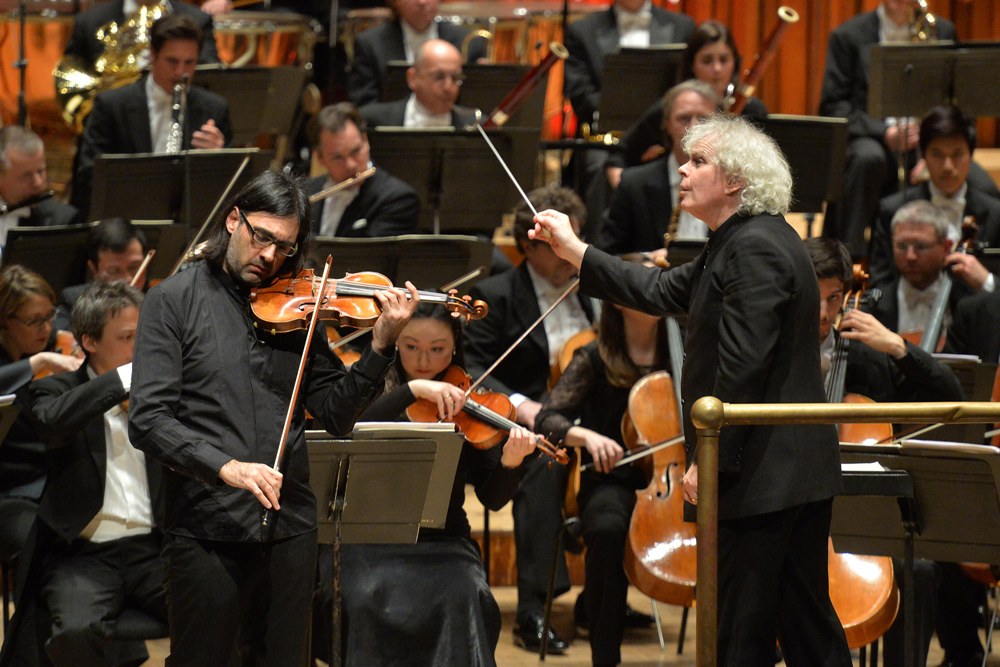Bass lines were Edward Seckerson’s starting point yesterday in welcoming the Berlin Philharmonic Sibelius cycle to London, and none strikes more terror from the depths than the subterranean growl that launches the most selectively-scored symphony of the 20th Century, the Fourth. Awe-inspiring is how it sounds on Sir Simon Rattle’s 1986 City of Birmingham Symphony Orchestra recording, with a little help perhaps from the engineer, and those eight Berlin Philharmonic double-basses last night were not going to stint on its force either.
Yet the beginning of the concert reminded us that cellos and a slightly smaller complement of basses also launch the Third Symphony at the opposite end of the dynamic scale, and in very different mode. Here they weren’t nearly light enough to herald a true sense of cheerful adventure, and Sibelius’s epic journey took on nothing like the spring and sense of direction it needed.
Call it the contrast between the power of the earth, which Rattle’s Berliners can always manage, and the energy of the human, which on this evidence isn’t their strong point. Rattle has made one of the best observations about John Adams's music, that it "always seemed to be moving forward in space", but he doesn't seem to be able to apply that to the supreme mover Sibelius. The Third's finale, which evolves with what should be imperceptible dynamism into something strong and noble, had too many bumps along the way and didn’t hit the peroration convincingly enough. A well-oiled machine and traffic lights aren’t necessary for Sibelius’s primal evolutions. Better were the circling motions of the fascinating, more-than-intermezzo middle movement, beautifully shaded with the peerless Berlin woodwind shining for the first of many occasions during the evening. But the hypnotic effect didn’t go quite as deep as in Sakari Oramo’s revelatory debut performance with the BBC Symphony Orchestra.
It was the same story with the Violin Concerto: outer movements problematic, core lyricism perfect. How Leonidas Kavakos (pictured above with Rattle and the Orchestra by Mark Allan for the Barbican) spun that central legato line, hooking us from first to last in the most conventional movement of the evening. He started unatmospherically, though, and never caught the sense of fantasy with which Lisa Batiashvili so bewitched at the Proms (again with Oramo). The last movement’s “dance with polar bears”, as the great musicologist Donald Tovey once put it, was dangerous in the wrong way, and a lovely bit of Bach by way of encore didn’t seem pertinent. It was good that the other players got to listen, but couldn’t they have prepared Sibelius’s delightful Humoresque No. 5 with their soloist? It hardly ever gets an airing in standard programming.
Once we struck the depths of the Fourth, earlier reservations were blown away. This time it’s my fault, not the orchestra’s, if tone-colours were so seductive that instead of thinking “what a mind-bending work” – which I know already – I couldn’t help registering instead at every turn “what astonishing artists”. It could hardly be otherwise with cellist Bruno Delepelaire – the noblest Don Quixote I’ve ever heard live in a Berlin performance of Strauss’s greatest symphonic poem – and flautist Emmanuel Pahud, though from both I wanted a bit more loneliness to temper the beauty of sound. Many of the best in this army of generals were out in force last night – including top oboist Albrecht Mayer; Andreas Ottensamer, the only clarinettist to win a recording contract of late; and viola player Amihai Grosz, formerly of the Jerusalem Quartet – and if it’s a good-looking orchestra too, well, that’s an incidental pleasure.
Rattle’s negotiation of each extraordinary idea and its mostly spare clothing couldn’t be faulted, but in my distraction at the sheer opulence of sound, perhaps I lost the line that builds every so slowly towards the tragic climax of the great Largo and the deeper sense of desolation in the symphony’s dying fall. Still, no doubt about it, this is a masterpiece that could have been written yesterday, and no-one makes you realize that quite like this super-orchestra.















Add comment